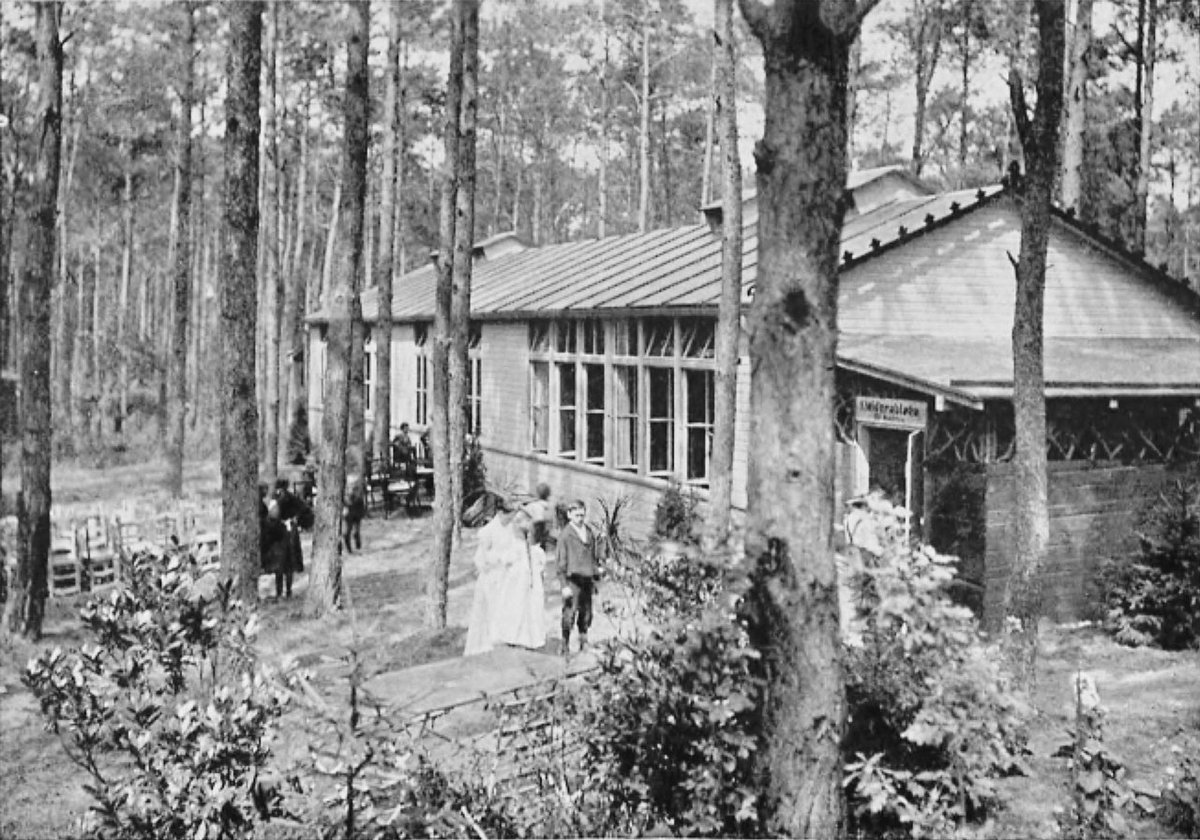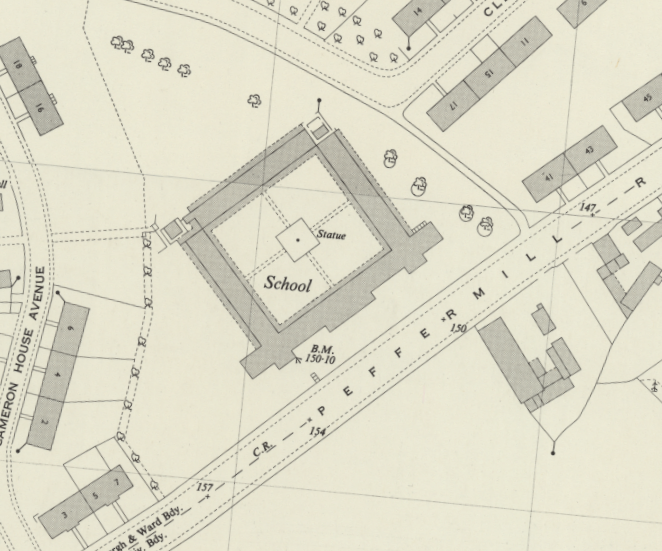
My new book is really, *really* interesting, not just about school buildings but about the social history that they go hand in hand with. A real work of labour and love of someone who (I think) spent their life working in Education.
https://twitter.com/cocteautriplets/status/1485559479026565121
There are distinct phases in school building programmes, as those charged with the provision of schools responded to legislation and the societal pressures at the time. What is very relevant to the current day is the effort they went to in responding to infectious diseases.
This became something of a guiding obsession in the period between WW1 and WW2 as the physical structure and design of schools was brought into service as a weapon in the war against infections diseases such as TB, cholera, typhus etc.
At the turn of the 20th century, the "Edinburgh Board School" was typified by Albion Road (later Norton Park), imposing, multistorey monuments to education crammed into very small plots in densely populated neighbourhoods, with 800-1000 children shoehorned into their classes 

The goal of these schools was to provide bums on seats capacity, to provide education to an every expanding school roll. Their planners imagined them as permanent monuments and as such the build quality was high and their finish was monumental.
At the same time in Edinburgh, the treatment ("the crusade against") Tuberculosis was being pioneered by Doctor Robert William Philip (later Sir Robert). He pioneered a coordinated approach to fighting TB. He opened the first TB clinic at 13 Bank Street in 1887. 

In 1894 he opened the Victoria Hospital for Consumption (TB) in Craigleith House, which would soon grow to become the Royal Victoria Hospital for Consumption, a roll it would fulfil until it became a Geriatric Hospital in the 1960s 

Dr Philip's integrated approach was "to isolate patients from family and friends and offer sun, fresh air and exercise". By 1906 this provision in the City had expanded to the City Hospital on the southern outskirts and even a farm in Polton for occupational isolation.
The British Government would not formally adopt Philip's approach until 1912, so Edinburgh really was at the cutting edge of response and treatment at the time. Edinburgh also had an unusually high rate of TB; but that's because Philip was so successful in identifying it.
Edinburgh's traditional "Board Schools" had always paid attention to ventilation as the Victorians had an obsession with "miasma", and also there was a fundamental snobbishness about the "unpleasant odors" of poor children. Look closely and there are ventilators *everywhere*. 







Voluntary notification for TB started in 1903 in Edinburgh. In 1907 it was made compulsory, 5 years before this nationally. In 1907 Scotland's first School Medical Officer was hired. A quest for clean air in Edinburgh's schools started in 1906 with air quality testing.
In a pioneering response, the health and education authorities worked together to tackle TB from all angles. In 1910 an awareness conference was organised for teachers and senior pupils. In 1911, 20,000 free calendars were given away in a "Crusade Against Consumption" campaign.
Recognising the role of malnutrition in weakening the immune system, in 1911 a "feeding centre" was established in Fountainbridge to provide free school meals for needy children. This later expanded into a "penny meals" service for those who could afford to pay a little. 

The authorities were of the conviction that you could actually stamp out a disease, not just treat its symptoms. And they saw the public health and the education departments as the tools to do this. Next, they turned their sites on the school buildings themselves.
In 1904 an "open air schools movement" had started in Charlottenburg near Berlin with the Waldschule für kränkliche Kinder (Forest school for sickly children). Children were taught outside where possible and the building was designed to allow as much of the outside in as possible 

Edinburgh was not slow to recognise the possibilities and in 1911 six members of the School Board were sent on a fact-finding mission to Cologne, Munich, Zurich, Paris and Middlesex to see how to do it for themselves.
On their return, such was the impression that was made that at a stroke, school design in Edinburgh changed forever. While the fully outdoor system was rejected on account of the city being "a northern temple of the winds", the theories were implemented
The new schools would be built on larger plots so that they could be single storey. They would be a single classroom deep to allow cross-ventilation and natural lighting from both sides. The buildings would be on the north of the plot to put the playground in the sun on the south
They also looked at schools as being less permanent temples to education, but more transient. They should be adaptable, cheaper to build, have room to expand as required. Bricks, wood and glass wood take over from the traditional, conservative Scots masonry.
The first of these new schools are typified by Balgreen and Stenhouse. They were only 2 storeys, with expansive glazing to the south and (originally) open verandas to the north. All the classrooms were arranged along a "spine" for through ventilation with facilities at the ends. 





They were built of brick and steel, but the conservative outlook of the School Board was impressed upon its architects and they still had traditional slate roofs and ventilator cowls, bricks hidden behind harling and restrained classical ornamentations in stone.
The City Architects developed these ideas into a "standard" school, with the south facing playground and classes, but arranged as arms rather than a spine. Craigentinny, Craigmillar, Niddrie Mill, Granton and other schools all followed this pattern. 







The adoption of this standardised design and the new construction methods also reduced costs. The 700 capacity Stenhouse and Balgreen came in at £43 per pupil. The "standard" schools of 800-1000 pupils reduced it to £27-32.
But although the architects and accountants had gotten the upper hand in those designs, those desirous of a more pure interpretation of the "open air movement" managed to get their way with one school, that of Prestonfield.
Prestonfield was "outsourced" to the Derbyshire school architect Bernard Widdows and even the casual eye can see from the map how different it is, arranged on a courtyard with all round verandas. 

And apart from the ends of the public facade to the south, it's a single storey, almost unique at the time. As an English architect, Widdows was confident enough of in the use of his materials not to hide the bricks away behind harling 

There were wide verandahs along the sides (now boxed in), with folding glass doors on the inside of the courtyard to open the rooms up to the fresh air. Three miles of underfloor heating pipes kept the place warm and children were encouraged to sit on the floor as a result. 



The inner courtyard had a sculpture in its centre, and each classroom was given a unique colour scheme. 

Sadly all this came at an expense, and at £50 per head - almost double the "city architects' standard" - the experiment was a one-off. But all these schools were fundamentally the "pavillion wards" of Dr Phillip's consumption hospitals in a classroom format 

These principals also carried over to nurseries for the poorer neighbourhoods, including the "Princess Elizabeth Child Garden" in Niddrie, again with the open verandas
https://twitter.com/StevenMRobb/status/1485242920429047812
And in 1935 the Children's House, also in Niddrie. You can see how the whole windows swing out and each room has a door onto the playground (pic Edinburgh City Libraries) 

Robert Philip died in 1939 at the age of 81. In his later years he declared TB to be “on the run” in Scotland. Since 1901 the death-rate for pulmonary TB in Edinburgh fell from 165/100k population to 48/100k in in 1950 and from non-pulmonary from 87/100k to 5/100k. 

Philip made took all sorts of enlightened approaches to his "crusade", one of which was hiring Miss Agnes Craig in 1906 as a health visitor. Edinburgh (and perhaps Scotland's) first female public health visitor.
It was Agnes' job to go into the home and explain and persuade people (mainly women) to implement preventative measures. "Her tall and stately figure was
a familiar one in working class districts where she proved to be a welcome and understanding visitor."
a familiar one in working class districts where she proved to be a welcome and understanding visitor."
Dr Phillip's Royal Victoria organisation was merged with the City's public health department in 1913 and Agnes continued her work, retiring in 1934 after 28 years’ tireless service. We are very lucky to have a picture of her at her work in a 1950 report by the Corporation. 

Anyway, the moral of the story is that over 100 years ago they knew about the importance of an integrated public health response and good ventilation and school design to combat airborne infectious diseases. And they did something about it.
Footnote, just found an aerial photo of the 1912 Tollcross primary from 1954, the architect was Carfrae - the same as Balgreen and Stenhouse - and you can see open air verandas at the back and on the extension. (pic from Britain From Above SAR021205) 

• • •
Missing some Tweet in this thread? You can try to
force a refresh






















